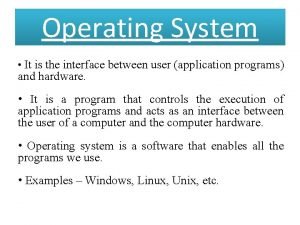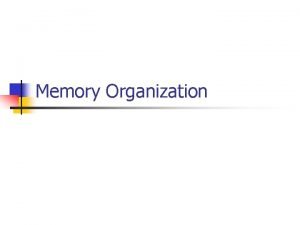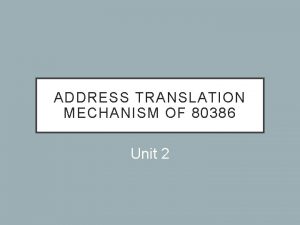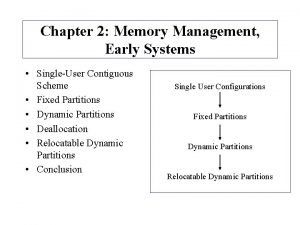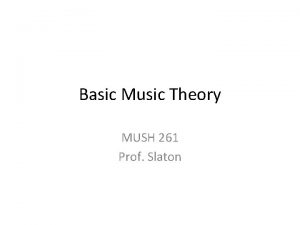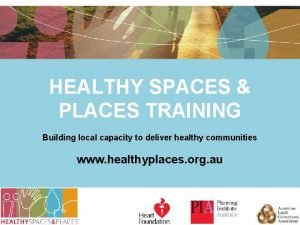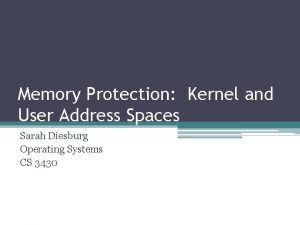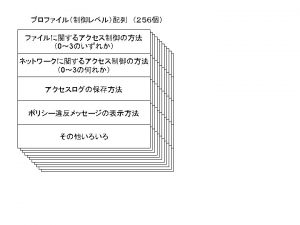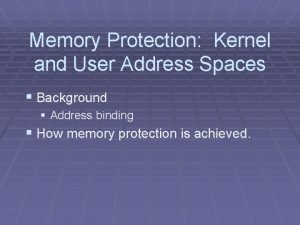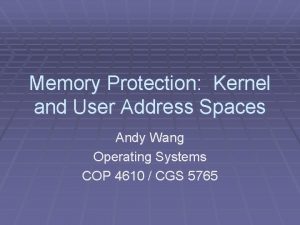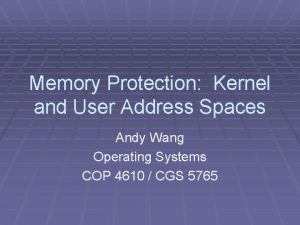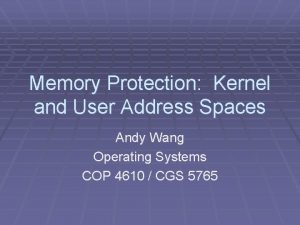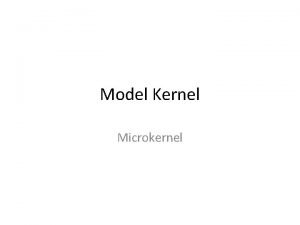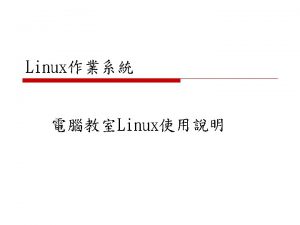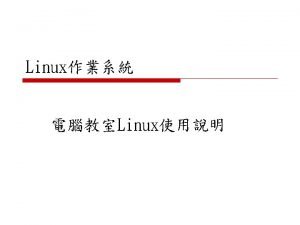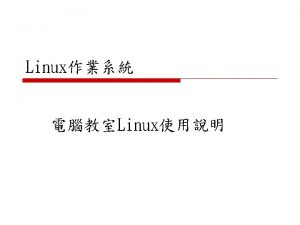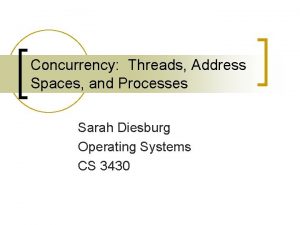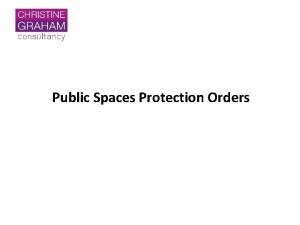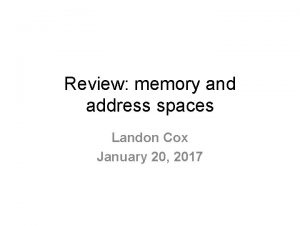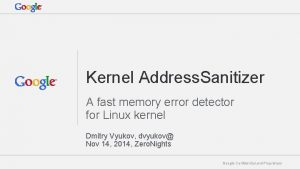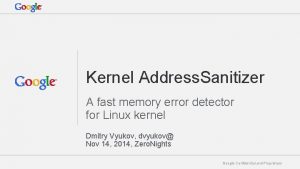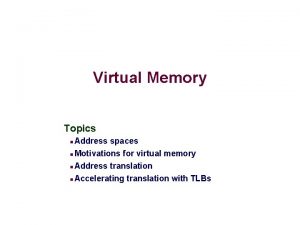Memory Protection Kernel and User Address Spaces Sarah



























- Slides: 27

Memory Protection: Kernel and User Address Spaces Sarah Diesburg Operating Systems COP 4610

Up to This Point • Threads provide the illusion of an infinite number of CPUs ▫ On a single processor machine • Memory management provides a different set of illusions ▫ Protected memory ▫ Infinite amount of memory ▫ Transparent sharing

Physical vs. Virtual Memory Physical memory Virtual memory No protection Each process isolated from all others and from the OS Illusion of infinite memory Limited size Sharing visible to processes Each process cannot tell if memory is shared

Memory Organizations • Simplest: uniprogramming without memory protection ▫ Each application runs within a hardwired range of physical memory addresses • One application runs at a time ▫ Application can use the same physical addresses every time, across reboots

Uniprogramming Without Memory Protection • Applications typically use the lower memory addresses • An OS uses the higher memory addresses • An application can address any physical memory location Application Operating system 000000 ffffff Physical memory

Multiprogramming Without Memory Protection • When a program is copied into memory, a linker-loader alters the code of the program (e. g. , loads, stores, and jumps) ▫ To use the address of where the program lands in memory

Multiprogramming Without Memory Protection • Bugs in any program can cause other programs to crash, even the OS Application 1 Application 2 000000 Operating system ffffff Physical memory

Multiprogrammed OS With Memory Protection • Memory protection keeps user programs from crashing one another and the OS • Two hardware-supported mechanisms ▫ Address translation ▫ Dual-mode operation

Address Translation • Recall that each process is associated with an address space, or all the physical addresses a process can touch • However, each process believes that it owns the entire memory, starting with the virtual address 0 • The missing piece is a translation table to translate every memory reference from virtual to physical addresses

Address Translation Visualized Translation table Virtual addresses Physical addresses

More on Address Translations • Translation provides protection ▫ Processes cannot talk about other processes’ addresses, nor about the OS addresses ▫ OS uses physical addresses directly No translations

Dual-Mode Operation Revisited • Translation tables offer protection if they cannot be altered by applications • An application can only touch its address space under the user mode • Hardware requires the CPU to be in the kernel mode to modify the address translation tables

Details of Dual-Mode Operations • How the CPU is shared between the kernel and user processes • How processes interact among themselves

Switching from the Kernel to User Mode • To run a user program, the kernel ▫ ▫ ▫ Creates a process and initialize the address space Loads the program into the memory Initializes translation tables Sets the hardware pointer to the translation table Sets the CPU to user mode Jumps to the entry point of the program

To Run a Program User level Kernel level Translation table PC Hardware pointer user mode

Switching from User Mode to Kernel Mode • Voluntary ▫ System calls: a user process asks the OS to do something on the process’s behalf • Involuntary ▫ Hardware interrupts (e. g. , I/O) ▫ Program exceptions (e. g. , segmentation fault)

Switching from User Mode to Kernel Mode • For all cases, hardware atomically performs the following steps ▫ Sets the CPU to kernel mode ▫ Saves the current program counter ▫ Jumps to the handler in the kernel The handler saves old register values

Switching from User Mode to Kernel Mode • Unlike context switching among threads, to switch among processes ▫ Need to save and restore pointers to translation tables • To resume process execution ▫ Kernel reloads old register values ▫ Sets CPU to user mode ▫ Jumps to the old program counter

User Kernel User level Kernel level set kernel mode PC handler PC trusted code register values translation tables (for processes)

Kernel User level Kernel level set kernel mode PC handler PC trusted code register values translation tables (for processes)

Kernel User level Kernel level PC handler user mode PC trusted code register values translation tables (for processes)

Communication Between Address Spaces • Processes communicate among address spaces via interprocess communication (IPC) ▫ ▫ Byte stream (e. g. , pipe) Message passing (send/receive) File system (e. g. , read and write files) Shared memory • Bugs can propagate from one process to another

Interprocess Communication • Direct ▫ send(P 1, message); ▫ receive(P 2, message); ▫ One-to-one communication • Indirect ▫ ▫ Mailboxes or ports send(mailbox_A, message); receive(mailbox_A, message); Many-to-many communication

Protection Without Hardware Support • Hardware-supported protection can be slow ▫ Requires applications be separated into address spaces to achieve fault isolation • What if your applications are built by multiple vendors? (e. g. , Firefox plug-ins) ▫ Can we run two programs in the same address space, with safety guarantees?

Protection via Strong Typing • Programming languages may disallow the misuse of data structures (casting) ▫ e. g. , LISP and Java • Java has its own virtual machines ▫ A Java program can run on different hardware and OSes - Need to learn a new language

Protection via Software Fault Isolation • Compilers generate code that is provably safe ▫ e. g. , a pointer cannot reference illegal addresses • With aggressive optimizations, the overhead can be as low as 5%

Protection via Software Fault Isolation Original instruction Compiler-modified version st r 2, (r 1) safe = a legal address safe = r 1 Check safe is still legal st r 2, (safe) § A malicious user cannot jump to the last line and do damage, since safe is a legal address
 Interface between user and kernel
Interface between user and kernel The kernel is unaware of user threads
The kernel is unaware of user threads Allocation map
Allocation map Remap_pfn_range example
Remap_pfn_range example Hardware address protection with base and limit registers
Hardware address protection with base and limit registers Logical address
Logical address Single user and multiple user operating system
Single user and multiple user operating system Operating systems
Operating systems Types of cache mapping
Types of cache mapping Logical to linear address translation
Logical to linear address translation Virtual memory address translation
Virtual memory address translation Microprogram example
Microprogram example Internal memory and external memory
Internal memory and external memory Primary memory and secondary memory
Primary memory and secondary memory Page fault
Page fault Single user contiguous storage allocation
Single user contiguous storage allocation Semantics prototype
Semantics prototype Implicit memory
Implicit memory Long term memory vs short term memory
Long term memory vs short term memory Which memory is the actual working memory?
Which memory is the actual working memory? Virtual memory in memory hierarchy consists of
Virtual memory in memory hierarchy consists of Eidetic memory vs iconic memory
Eidetic memory vs iconic memory Shared memory vs distributed memory
Shared memory vs distributed memory Which type of drainage system drains spaces forward and aft
Which type of drainage system drains spaces forward and aft Alto clef notes
Alto clef notes The bass and treble staffs connected by a brace
The bass and treble staffs connected by a brace Tenor clef lines and spaces
Tenor clef lines and spaces Healthy spaces and places
Healthy spaces and places
